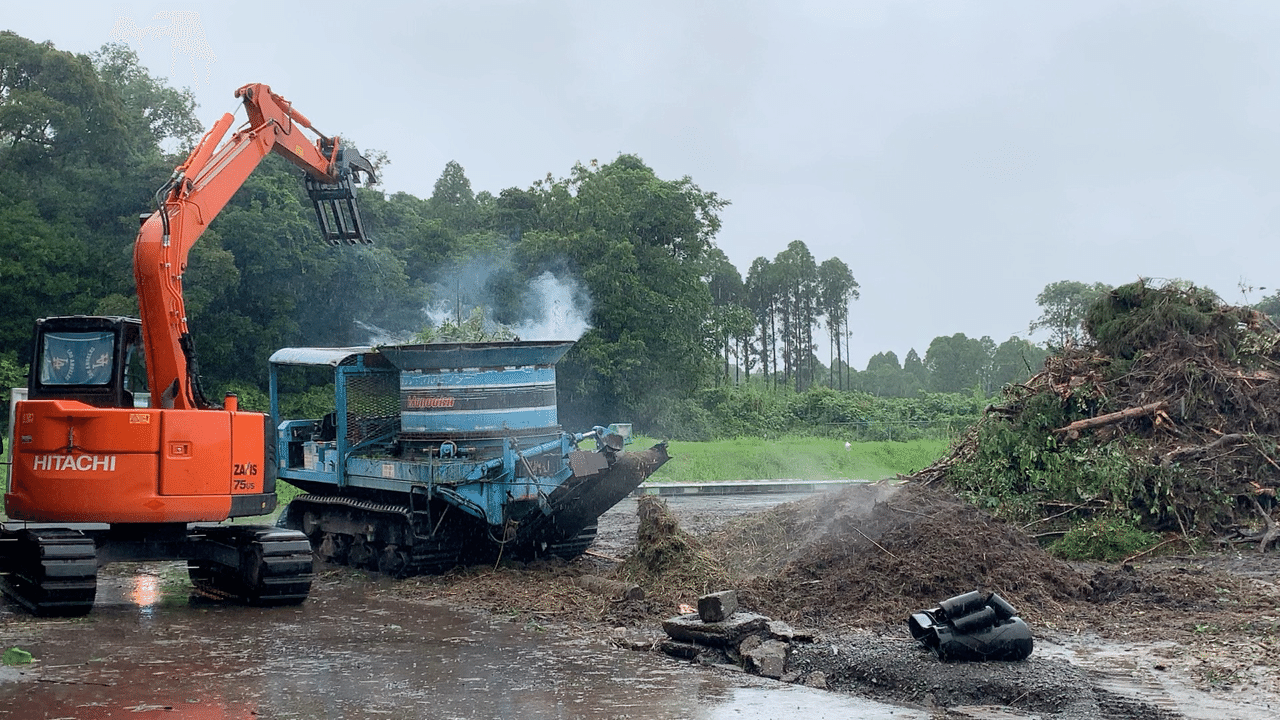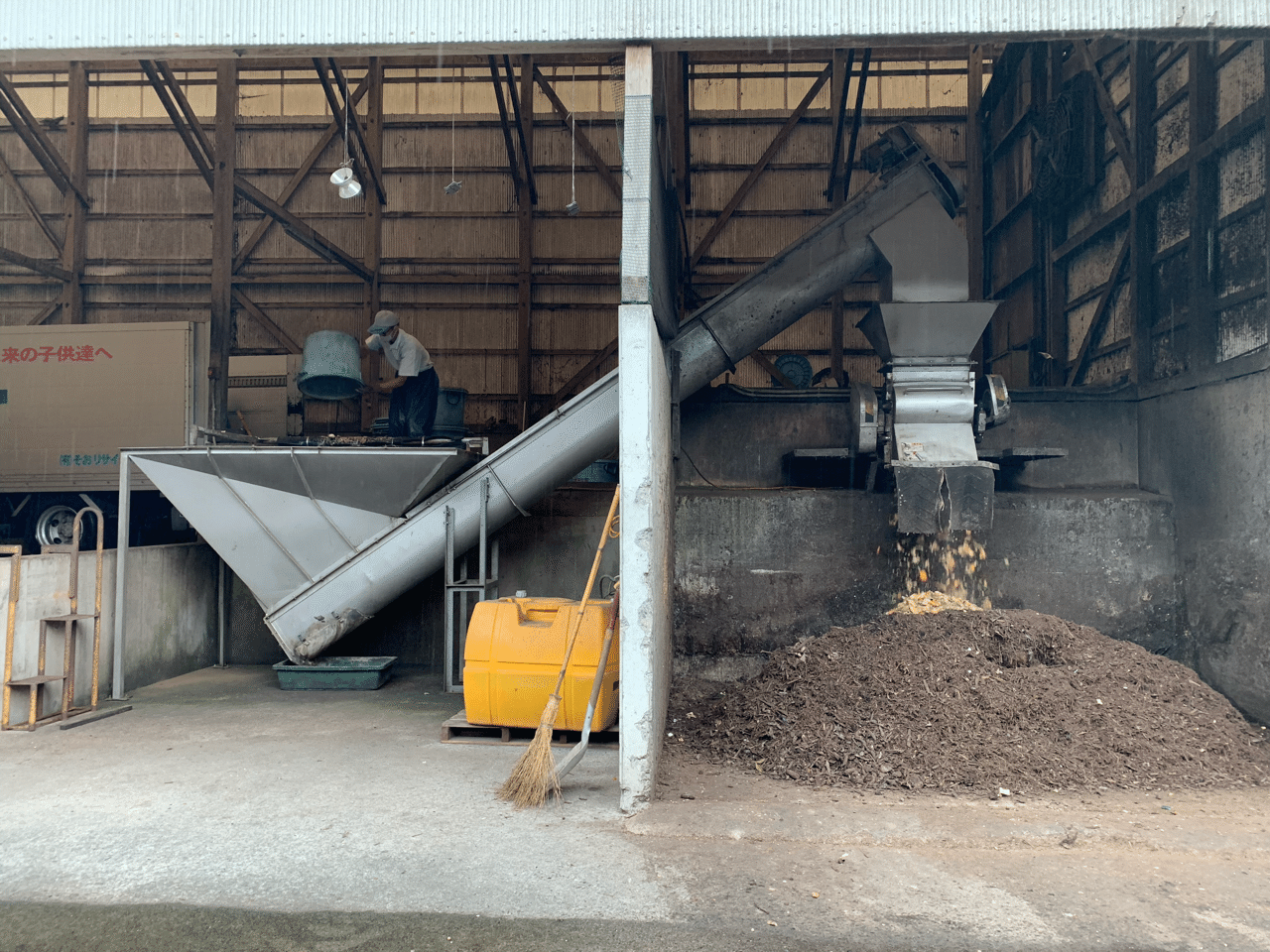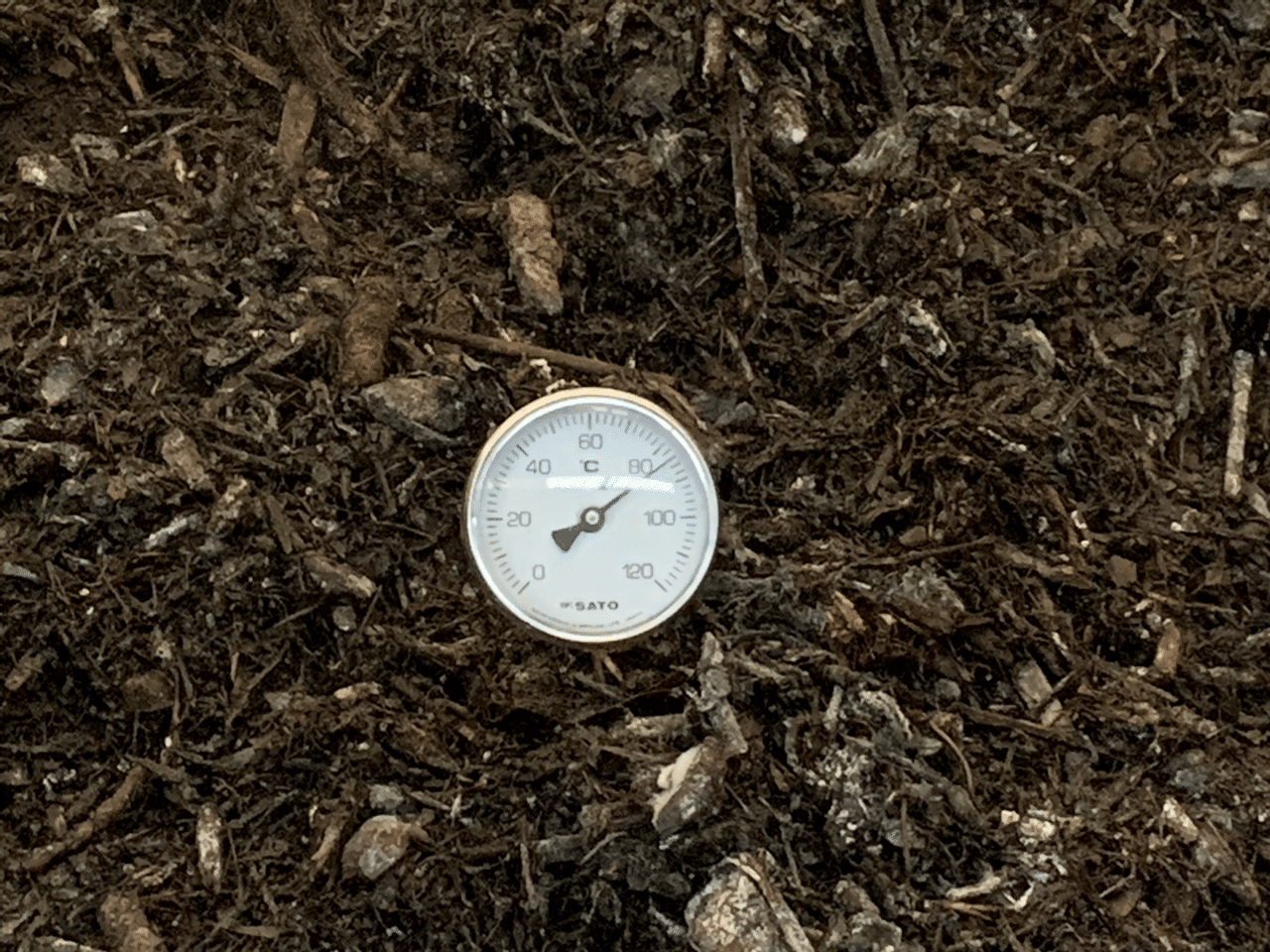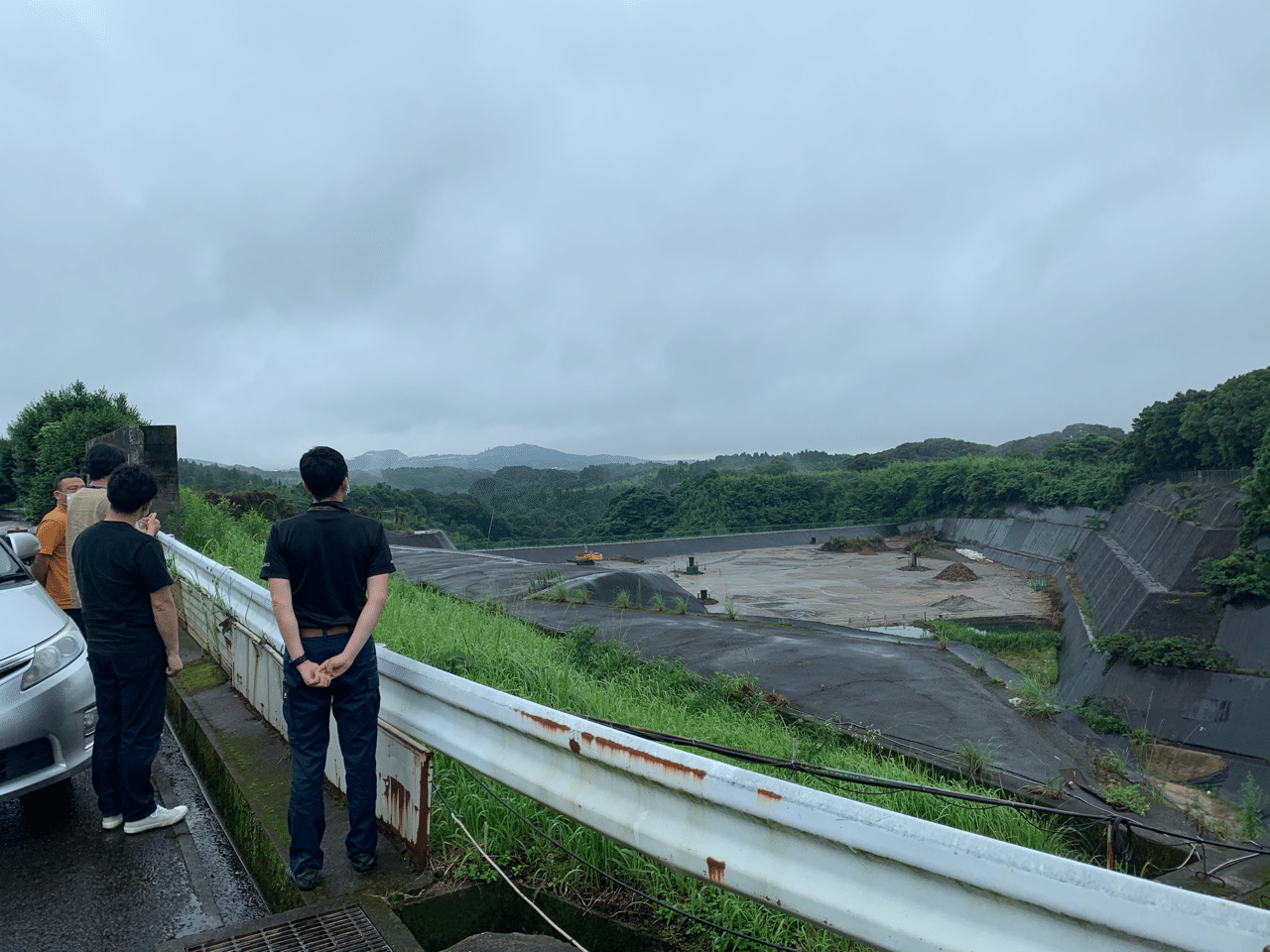
見える、見えない。〜リサイクルの町大崎で見えてきたもの
ー Visible, Invisible. 〜Things I felt in Osaki, the town of recycling ー
もう何度目か分からない(笑)、大崎町の見学に行ってきました。

大崎町はここです。(大崎町公式HPから画像拝借)
鹿児島空港から車で1時間くらいの小さな町ですが、いろんな意味で素晴らしい。
何度も足を運び、ぼんやりと その素晴らしさの根っこのようなものが見えてきたので、noteにまとめることにしました。
Osaki is a town with a population of 13,000 people in the Osumi Peninsula in Kagoshima Prefecture. ( the map is borrowed from the Osaki town's official website)
Osaki is a small town about an hour's drive from Kagoshima Airport, but it's wonderful in many ways.
I've been to the town many times, and now I can vaguely see the essence of its greatness, so I decided to write about it.
町で出る生ゴミを全て堆肥化
Composting all the food waste in town.

何度見学させていただいても感動する「有機工場」。
町全体で出るゴミの、実に6割以上が生ゴミ。
その全てがここで堆肥化されています。
上の写真は町内から持ち込まれた草木を粉砕している様子。ここ最近の豪雨の影響で、ひっきりなしにトラックが出入りしていました。
The organic plant is always impressive no matter how many times I visit.
In fact, more than 60% of the garbage in the entire town is food waste.
and all of it is composted here.
The photo above shows the plants and trees which were brought from the town being crushed.Because of the recent heavy rains, trucks were constantly coming and going.

粉砕した草木と、生ゴミとをおよそ1:1の比率で混ぜます。
ちなみに生ゴミを粉砕しているこの機械は、焼酎工場でサツマイモを加工するためのものなのだそう。
Plant and tree is mixed with the garbage at a ratio of about 1:1.
Incidentally, this machine that crushes the garbage is for processing sweet potatoes at the Shochu factory.

生ゴミは週に3回このバケツで回収されて、この有機工場に集められます。
生ゴミを捨てた後のバケツは水洗いせずに、おが屑に水分を吸わせてまたそれぞれの自治会に。
水で洗うと大量の汚水が発生しますが、生ゴミから出る水分も1滴残らず活用するというから驚きです。
Food waste is collected in these buckets three times a week and brought to this organic plant.
The buckets are not rinsed with water after the garbage is thrown away, but are returned to each community with sawdust to absorb the water.
It's amazing that every drop of water from the garbage is used in the composting process.

生ゴミの処理施設というと、それなりの悪臭はつきものなのかと思いきや、深呼吸できるレベルに臭くない。
その秘密がこの乳酸菌です。
もともとはEM菌など、さまざまなものを試したらしいのですが、最後に行き着いたのは、この有機工場の近隣に生息しているよもぎに黒糖を混ぜて培養する乳酸菌。「土着菌が一番効果がありました」という言葉が、なんだか神々しく聞こえます。
しあわせの青い鳥は、本当に近くにいるんだなぁという感覚。
Talking about the facility of garbage, do you think that a certain bad smell is common, but it does not smell to the level that allows us to take a deep breath.
The key is the lactic acid bacteria.
They tried various things, such as EM bacteria, before reaching this point. In the end, they came up with the lactobacilli which are made from the mugwort growing nearby this organic plant and brown sugar. The words "the indigenous bacteria were the most effective" sound somewhat divine.
The blue bird of happiness is always with us.

夏のこの時期に、ハエ1匹いないって本当にすごいです。(7月16日撮影)
この1山で大崎町全体の生ゴミ3日分くらいだそう。
粉砕した草木と、生ゴミ、そして乳酸菌。これらを混ぜて放置するだけで、どんどん発酵が進みます。
also, in this time of the summer, it is really amazing that there is no fly. (Photo taken on July 16)
This one pile is about 3 days' kitchen garbage of the whole Osaki town. Crushed plants and trees, garbage and lactic acid bacteria. Fermentation proceeds rapidly only by mixing these things and leaving it.


温度を計ると、こんな感じ。
ここでしっかり温度を上げて、生ゴミの中に含まれる種を焼き切ることと、悪い菌を殺すことが大事なのだそう。
When we measure the temperature, it is like this.
It is important to raise the temperature properly so that the seeds contained in the garbage are burned off and the bad bacteria are killed.
発酵が弱まってきたら、水(生ゴミから出たものを活用)と空気を補充するためにこのように重機で撹拌します。
一気に立ち上る湯気に、自然のすごさを感じます。
Once the fermentation has weakened, the water (utilizing what comes out of the garbage) and air are stirred in with a bulldozer like this.
I feel the awesomeness of nature as the steam rises up.

そして。
約半年熟成させて出来上がった堆肥がこちら。
And. This is the compost that has been matured for about half a year.


おかえり環ちゃん。
(ちなみにお隣の志布志市の堆肥は「おかえり循ちゃん」なんだとか❤️)
一般のお店ではなく、大崎町役場とこの有機工場で 他の堆肥と比べるとかなり安い価格で販売されています。「そもそも原料は住民のものだから」という考え方らしく、同時に きれいな形で循環してこそのこのシステムという思いがあるようです。
The product name of the compost is "Okaeri Kan-chan ("welcome back Kan-chan").
By the way, the compost made in the same way in Shibushi city is called "Okaeri-Kyun-chan" ;) JunKan means Circulation in Japanese.
The compost is sold at the Osaki Town hall and this organic factory at a much cheaper price compared to other compost shops.
They think that the ingredients belong to the citizens, and they want to recycle the compost in a perfect form.
堆肥が売れない?!
No one buys compost!?
それでも開発当初は「生ゴミからできた肥料なんて」となかなか受け入れてもらえなかったそう。
This system, which is now depicting a beautiful circulation, was not accepted by the people at first. it was difficult to get people to accept the idea of a fertilizer made from food waste.

ここで諦めないのがこの有機工場(民間企業です!)のすごいところ。
自分たちで、この肥料を使って有機野菜を栽培し「よいものである」ことを証明。
もう一つすごいのが菜の花を栽培し、食用の菜種油を開発。
However, this organic factory (a private company!) did not give up.
They used this fertilizer to grow their own organic vegetables, showing that they are "good".
Another amazing thing is that they grew canola flowers and developed edible canola oil.


油は、学校給食や家庭の調理に使われたあと再度回収されて、なんとゴミ収集車の燃料として活用されているという徹底ぶりです。
The oil is used for school lunches and home cooking, and then collected again to be used as fuel for garbage trucks.

そしてこのすごいシステムを回しているのは、なんと2人!名付けて「いきものがかり」。
今ではここで作られた堆肥、すっかり住民にも受け入れられて、しっかりと「循環」しているようです。
(ちなみに大崎町の食料自給率は400%!)
尊敬します。
And this amazing system is run by two workers!
The compost produced here is now well accepted by the residents and seems to be well circulated.
(By the way, the food self-sufficiency rate in Osaki is over 400%)
I really do respect them.
きっかけは、埋立処分場の寿命問題
The trigger was the limits of the landfill.

遡ること20年。
焼却炉のない大崎町が大きな課題に直面しました。
「もうすぐ埋立処分場が満杯になる」
当時すべてのゴミを埋め立てていたこともあり、処分場周辺はひどい異臭や、カラスなど被害に悩まされていました。
焼却施設を作る費用とランニングコストは、それまでの埋立処分とは比べ物にならないほどの負担増。
とはいえ、もう一つ埋立処分場を作ろうにも住民の賛成が得られる場所が見つからない。
苦肉の策として考えたのが、ゴミを27品目に分別して埋立処分場の延命化を図るという手段。
Going back 20 years.
Osaki, with no incinerators, was faced with a serious problem.
"The landfill site will be full soon."
Since all the trash was being landfilled at the time, the area around the landfill was plagued with terrible odors and crows.
The cost of building an incineration facility and the running costs were far greater than the cost of landfill disposal.
However, it was also difficult to find a location for another landfill site because the residents could not give their approval.
As a result, they decided to extend the life of the landfill site by separating the garbage into 27 items.

27!!!
とびっくりしますが、大崎町の皆さん曰く「普段分けるのは5-6種類程度で、あとはまとめておいたものを定期的にみんなでこうやって分けるだけだから、思ったよりは負担大きくないですよ」とのこと。
Twenty-seven!
However, people in Osaki-cho say, "We usually separate about 5-6 kinds of garbage, and the rest of items are sorted out with other people on a regular basis, so it's not as big a burden as you think.

生ゴミ以外のゴミのほとんど(下着や鼻をかんだ後のティッシュ、靴などは埋め立てる)は、この そおリサイクルセンターに運ばれます。
Most of the garbage other than food waste is taken to the Soo Recycling Center. (Underwear, tissues after blowing your nose, shoes, etc. go to the landfill.)

大崎町の皆さんは、全てゴミを洗ってリサイクルに出しているので、買取評価額も高いのだそう。
住民が一丸となって取り組むことで、ゴミ処理にかかるコストは半減。その浮いたコストと資源ゴミの売却益は、そのまま住民に還元されているとのこと。
The people of Osaki Town wash all their garbage and send it to the recycling center, so the buy-back valuation is high.
By working together as a group, the cost of garbage disposal has been reduced by half. The saved cost and the profit from the sale of the recyclable waste is returned to the residents as it is.
人懐っこさと、当事者意識
Friendliness and the sense of responsibility
大崎町の魅力はリサイクル。
それはもちろんなんですが、何度か足を運ぶ人が口を揃えて言うのが、住民の当事者意識とゆるやかな(でも温かくしっかりとした)横のつながりです。
The charm of Osaki Town is recycling.
But what people who come here several times also say is that the residents have a sense of responsibility and loose (but warm and firm) relations with each other.

Among the entire cycle, including consumption behavior, what we see is the very short range from purchase to discard. I noticed that the other stages are not visible at all.
大崎町に来て感じるのは、普段の自分の暮らしの中にあるいろんな繋がりの、全体が見えていることの少なさ。
めんどくさいことに全て蓋をして、見ないことにした結果が今の社会の不安定さや、底知れぬ不安感を生んでいるのかもしれないなと思います。
今日買ったものはどこから来て、昨日捨てたゴミはどこにいったのだろう。私自身そこは全然見えていません。
What I feel when I come to Osaki is that there are so few connections in my daily life that I can see the entirety of them.
I think that the current instability in our society and the unfathomable anxiety might be the result of our ignoring all the bothersome things we do.
Where did the things we bought today come from and where did the garbage we threw away yesterday go? I can't see that at all myself.
もっと川上から
More from upstream.
リサイクル率80%以上を誇る大崎町にいても感じること。
Even though Osaki Town is proud of its recycling rate of more than 80%, I still feel that.










それは「本当にこれだけのゴミを出さないと人は生きていけないのかな?」という問い。
リサイクルするからいい
燃やせばいい
埋めればいい、、、?
もう後戻りできない日が来る前に。
なんとかしたいです。
Do we really need to produce this much garbage to live?
Okay, I'll recycle it.
We can burn it.
We can bury it, yes?
Before the day comes when we can no longer turn back.
I want to take action that will lead to a solution.
この記事が気に入ったらサポートをしてみませんか?
